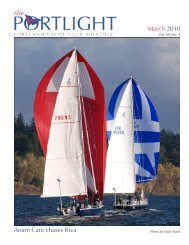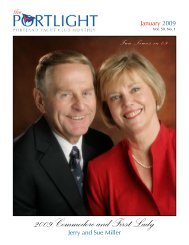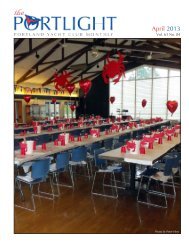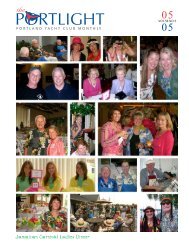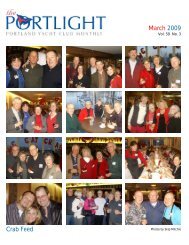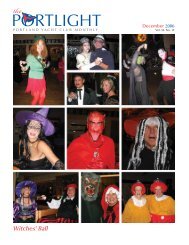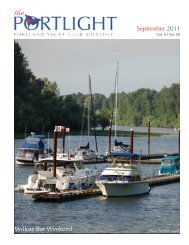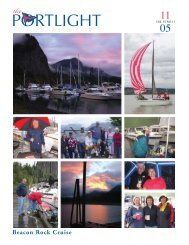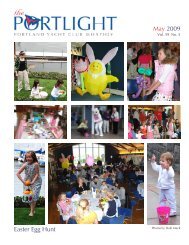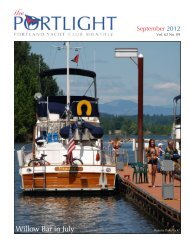Feb - Portland Yacht Club
Feb - Portland Yacht Club
Feb - Portland Yacht Club
Create successful ePaper yourself
Turn your PDF publications into a flip-book with our unique Google optimized e-Paper software.
PAGE 9 | The Portlight | 02.05<br />
GROWING UP AT PYC<br />
W<br />
hen I was young, my father resigned<br />
his position with the Studebaker<br />
Corporation because they wanted to transfer<br />
him to another part of the country. He<br />
wanted to stay in the Northwest. Then the<br />
Wall Street crash of ’29 occurred, and he<br />
was out of a job.<br />
He was Vice-Commodore of <strong>Portland</strong><br />
<strong>Yacht</strong> <strong>Club</strong> at the time, and the board was<br />
considering hiring an on-site manager.<br />
They offered him the job, at least for the<br />
summer… he stayed for 15 years! His title<br />
was Port Captain, so he became known as<br />
“Cap.” We moved into quarters above the<br />
ballroom in the old club house. When the<br />
new club house was built, the old one was sold,<br />
and moved to a location on Interstate Avenue.<br />
The only transportation available in those<br />
days, other than the auto, was the streetcar.<br />
It came down Union Avenue (now Martin<br />
Luther King, Jr., Blvd) to Columbia Blvd.<br />
At that point, it took off on a trestle to<br />
Faloma Street and then across the slough to<br />
Hayden Island, where it linked up with the<br />
Interstate Bridge and continued on into<br />
Vancouver. To this day, the end of the old<br />
trestle pilings and rocks has a green marker<br />
that you pass as you travel down the slough<br />
toward the I-5 bridge.<br />
One winter the river froze over from bank<br />
to bank. It was rumored that a car was driven<br />
across and a sternwheeler was trapped in<br />
the ice for a while. One spring the river<br />
came up to within a few inches of the ballroom<br />
floor. The river was much higher during<br />
the flood of 1948, when the water was<br />
4-5 feet deep over the floor, but it was still<br />
kind of scary living there at the time.<br />
In those years, the club had quite a few members<br />
who owned canoes, small sailboats and<br />
runabouts such as Chris-Craft, Dodge, etc.<br />
They were dry stored in a large floating<br />
building. Some were light enough to be<br />
picked up and carried to storage racks.<br />
Others entered a slip and were picked up by a<br />
hoist that traveled on an overhead I-beam,<br />
pushed into the house, and lowered onto<br />
a cradle. Since the cradles had casters on<br />
them, they could be pushed around into<br />
their storage spaces.<br />
Mother (Mauni) cooked dinner for the<br />
Board of Directors before their monthly<br />
meetings for a period of time. She also was<br />
asked to take over the job of bookkeeper. It<br />
was a position she enjoyed and continued<br />
doing for 40 plus years. Many of you may<br />
not know that PYC’s Mauni Elliott sailboat<br />
races are named after my mother.<br />
Activity on the river was pretty slow until<br />
the first Saturday in May (Opening Day,)<br />
just as it is now. Opening Day was an all<br />
day affair with flag raising ceremonies, the<br />
boat parade, sailboat races, an afternoon<br />
tea, and a formal dance. Of course, we were<br />
the only club around in those days.<br />
There were cruises to Willow Bar (the present<br />
site of our Outstation) and to the Lewis<br />
River where a farmer would bring fresh<br />
strawberries, cream, and the Sunday papers<br />
down to the boats that were tied to the<br />
bank. The big summer cruise was the<br />
Rooster Rock Barbeque. We would put up<br />
large tents for serving food, awarding<br />
prizes, and providing shade for the pop, ice<br />
cream, and beer. The drinks and ice cream<br />
were buried in the sand with lots of ice and<br />
wet burlap over the top. There were swimming<br />
races, dinghy races, sack and three-legged<br />
races. Also, a nail driving contest, soft ball<br />
throw, and many other events. Cap would<br />
hit up all the local merchants for donations<br />
to be awarded as prizes. But the best thing<br />
about the cruise was the barbeque. We took<br />
an old southern black gentleman named<br />
George Washington Jackson with us to the<br />
park. On Saturday, with some help from<br />
the kids, he would get his pit dug. He’d get<br />
up very early Sunday morning and start his<br />
fires. Then in the afternoon we would get<br />
wonderful pork ribs, beef ribs, and lamb all<br />
mopped with his “secret sauce.” It was<br />
wonderful, and everyone would go home<br />
with a full tummy and probably a sunburn.<br />
Though not an official cruise, quite a few<br />
members took their vacation time at the<br />
end of August and first part of September<br />
to cruise to Ilwaco. You could go fishing,<br />
sightseeing or hiking, and of course, there<br />
were the great raised glazed doughnuts at<br />
the local bakery. One of our members loved<br />
the kids, and he would organize us to hike<br />
to the beach and collect firewood. Then<br />
that night everyone would go to the beach<br />
for a huge bonfire and wiener roast. After a<br />
week or so, we’d cruise to Astoria for their<br />
annual Regatta, which was bigger than it is<br />
now. All sorts of races were held—fish boat,<br />
sailboat, speedboat, etc. Usually a big name<br />
band came to town and added to the festivities.<br />
Everybody usually went home after Labor Day.<br />
Sailing and sailboat racing were gaining in<br />
popularity on the Columbia. At one time<br />
or other we had organized classes of 16’<br />
Snipes, 18’ Flatties, and 28’ Crods. Also,<br />
there were usually a couple of handicap<br />
classes. There were some odd things done<br />
in those days, such as starting or finishing a<br />
race at the gas dock, or sailing through the<br />
cut between Hayden and Tomahawk<br />
Island, which is now filled in. There was a<br />
large gilnetter fleet in those days, and they<br />
mostly lived on the Oregon shore, downriver<br />
from PYC. Occasionally, a gilnetter<br />
would pick up a race buoy in his net,<br />
although we tried to set them as far inshore<br />
as possible. Cap would get in the work boat<br />
and go down to their place and with the<br />
“possible” help of a bottle of bourbon,<br />
barter with the gilnetter to get the buoys back!<br />
December 7, 1941 brought about a lot of<br />
changes. Many members joined the U.S.<br />
Coast Guard Auxiliary. They painted their<br />
boats “Battleship Grey” and put large white<br />
CGA numbers on the bows. Once or twice<br />
a week, we would patrol various facilities<br />
along the river from sundown to sunup. Of<br />
course, we got to watch them building the<br />
Vancouver Shipyards and then the ships. As<br />
I recall, one of the first ships launched ran<br />
aground on the tip of Tomahawk Island…<br />
Glenn Elliott<br />
*Editor’s note: Glenn has been a member of PYC since 1939.<br />
Glenn and Lois were Commodore and First Lady in 1980.



